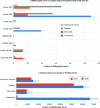The rise and fall of global health issues: an arenas model applied to the COVID-19 pandemic shock
- PMID: 33781272
- PMCID: PMC8006127
- DOI: 10.1186/s12992-021-00691-7
The rise and fall of global health issues: an arenas model applied to the COVID-19 pandemic shock
Abstract
Background: The global health agenda is ill-defined as an analytical construct, complicating attempts by scholars and proponents to make claims about the agenda status of issues. We draw on Kingdon's definition of the agenda and Hilgartner and Bosk's public arenas model to conceptualize the global health agenda as those subjects or problems to which collectivities of actors operating nationally and globally are paying serious attention at any given time. We propose an arenas model for global health agenda setting and illustrate its potential utility by assessing priority indicators in five arenas, including international aid, pharmaceutical industry, scientific research, news media and civil society. We then apply the model to illustrate how the status of established (HIV/AIDS), emergent (diabetes) and rising (Alzheimer's disease) issues might be measured, compared and change in light of a pandemic shock (COVID-19).
Results: Coronavirus priority indicators rose precipitously in all five arenas in 2020, reflecting the kind of punctuation often caused by focusing events. The magnitude of change varied somewhat by arena, with the most pronounced shift in the global news media arena. Priority indicators for the other issues showed decreases of up to 21% and increases of up to 41% between 2019 and 2020, with increases suggesting that the agenda for global health issues expanded in some arenas in 2020- COVID-19 did not consistently displace priority for HIV/AIDS, diabetes or Alzheimer's disease, though it might have for other issues.
Conclusions: We advance an arenas model as a novel means of addressing conceptual and measurement challenges that often undermine the validity of claims concerning the global health agenda status of problems and contributing causal factors. Our presentation of the model and illustrative analysis lays the groundwork for more systematic investigation of trends in global health agenda setting. Further specification of the model is needed to ensure accurate representation of vital national and transnational arenas and their interactions, applicability to a range of disease-specific, health systems, governance and policy issues, and sensitivity to subtler influences on global health agenda setting than pandemic shocks.
Keywords: Agenda setting; Alzheimer’s disease; Arenas model; COVID-19; Coronavirus; Diabetes; Global health; HIV/AIDS.
Conflict of interest statement
The authors declare that they have no competing interests.
Figures






Similar articles
-
Civil society priorities for global health: concepts and measurement.Health Policy Plan. 2023 Jun 16;38(6):708-718. doi: 10.1093/heapol/czad034. Health Policy Plan. 2023. PMID: 37217184 Free PMC article.
-
Shifting patterns and competing explanations for infectious disease priority in global health agenda setting arenas.Health Policy Plan. 2024 Sep 10;39(8):805-818. doi: 10.1093/heapol/czae035. Health Policy Plan. 2024. PMID: 38753344 Free PMC article.
-
Analysing the global health agenda: A comparison of priority for diabetes and oral diseases.Glob Public Health. 2021 Apr;16(4):517-531. doi: 10.1080/17441692.2020.1814834. Epub 2020 Sep 9. Glob Public Health. 2021. PMID: 32903145
-
Practicing Corona - Towards a research agenda of health policies.Health Policy. 2020 Jul;124(7):671-673. doi: 10.1016/j.healthpol.2020.05.010. Epub 2020 May 15. Health Policy. 2020. PMID: 32425282 Free PMC article. Review.
-
The emergence of a global right to health norm--the unresolved case of universal access to quality emergency obstetric care.BMC Int Health Hum Rights. 2014 Feb 27;14:4. doi: 10.1186/1472-698X-14-4. BMC Int Health Hum Rights. 2014. PMID: 24576008 Free PMC article. Review.
Cited by
-
Civil society priorities for global health: concepts and measurement.Health Policy Plan. 2023 Jun 16;38(6):708-718. doi: 10.1093/heapol/czad034. Health Policy Plan. 2023. PMID: 37217184 Free PMC article.
-
Comparing priority received by global health issues: a measurement framework applied to tuberculosis, malaria, diarrhoeal diseases and dengue fever.BMJ Glob Health. 2024 Jul 8;9(7):e014884. doi: 10.1136/bmjgh-2023-014884. BMJ Glob Health. 2024. PMID: 38977402 Free PMC article.
-
Transforming Social Determinants to Educational Outcomes: Geospatial Considerations.Healthcare (Basel). 2022 Oct 9;10(10):1974. doi: 10.3390/healthcare10101974. Healthcare (Basel). 2022. PMID: 36292421 Free PMC article.
-
Shifting patterns and competing explanations for infectious disease priority in global health agenda setting arenas.Health Policy Plan. 2024 Sep 10;39(8):805-818. doi: 10.1093/heapol/czae035. Health Policy Plan. 2024. PMID: 38753344 Free PMC article.
References
-
- Esser DE, Keating BK. Does global health funding respond to recipients’ needs? Comparing public and private donors’ allocations in 2005–2007. World Dev. 2011;39(8):1271–1280. doi: 10.1016/j.worlddev.2010.12.005. - DOI
-
- Pitt C, Grollman C, Martinez-Alvarez M, Arregoces L, Borghi J. Tracking aid for global health goals: a systematic comparison of four approaches applied to reproductive, maternal, newborn, and child health. Lancet Glob Health. 2018;6(8):e859–ee74. doi: 10.1016/S2214-109X(18)30276-6. - DOI - PMC - PubMed
-
- Baumgartner FR, Jones BD. Agendas and instability in American politics 1st ed. Chicago: University Of Chicago Press; 1993.
-
- Birkland TA. After disaster: agenda setting, public policy, and focusing events. Rabe B, Tierney J, editors. Washington: Georgetown University Press; 1997.
MeSH terms
Grants and funding
LinkOut - more resources
Full Text Sources
Other Literature Sources
Medical

